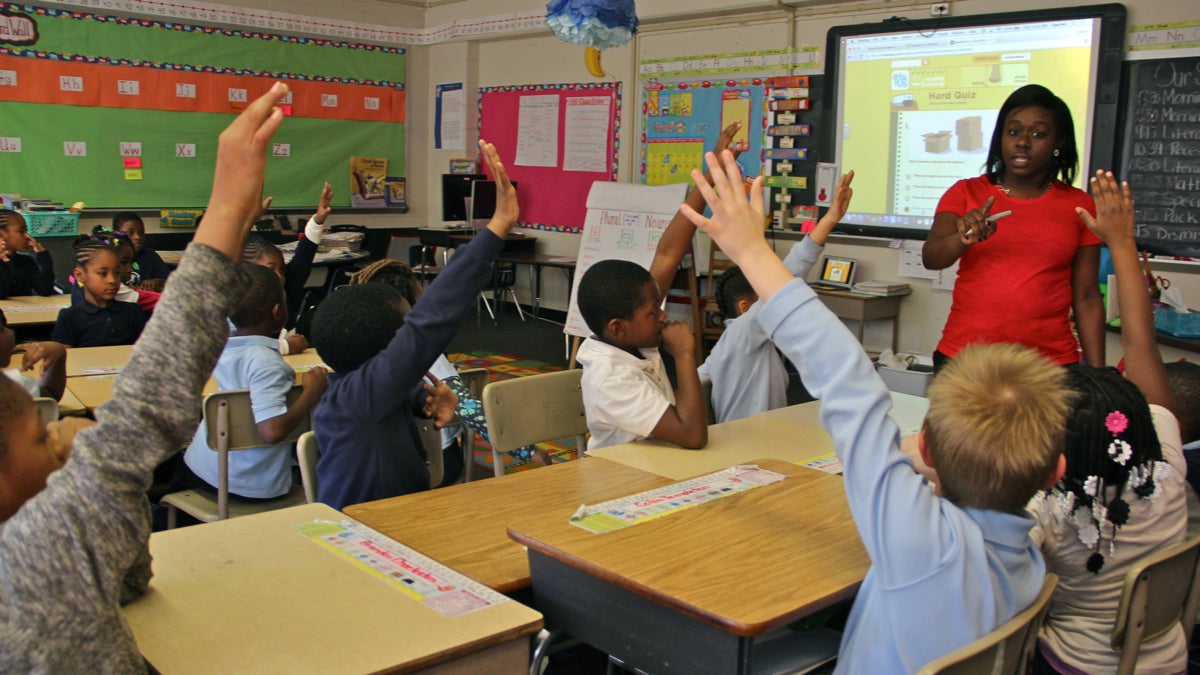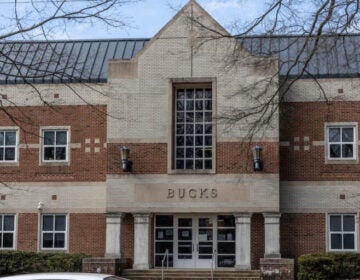Philly research suggests simple postcards help keep students in class
Listen
Second-graders raise their hands at Chester Arthur Elementary School. (Emma Lee/WHYY
Research out of Philadelphia suggests the best medicine for absenteeism might be a postcard sent home with a dose of cold, hard truth.
It is a problem as old as school itself — how do you keep kids from missing time in the classroom?
Research out of Philadelphia suggests the best medicine for absenteeism might be a postcard sent home with a dose of cold, hard truth.
Sending Philadelphia public school families a single postcard emphasizing the importance of attendance reduced absenteeism by 2.4 percent, according to a study released this month by the Institute of Education Sciences at the U.S. Department of Education.
Further research — still in draft form — suggests an even more effective remedy: sending families postcards that tell them how often their kids have missed school. In Philadelphia, students from families who received these blunt missives missed one less day of school than their classmates in a control group.
Taken together, the studies indicate that snail-mail may be a cheap and effective way to chip away at chronic absenteeism, a problem that plagues many large, urban school districts.
The theory for this simple intervention comes from the world of behavioral science. And it may be familiar to those who’ve received an energy bill, many of which now come with data comparing the recipient’s energy usage to that of his or her neighbors. The purpose of that information is to reduce future consumption by confronting people with their own waste.
Todd Rogers, a public policy professor at Harvard University’s Kennedy School of Government, and officials at the School District of Philadelphia decided they would use this thinking to attack the problem of absenteeism.
After all, you can’t learn if you don’t show up. And absence rates are a reliable predictor of academic performance and graduation rates.
Rogers’ experiment divided families into four groups. The first received no postcards. The second received postcards simply extolling the virtues of attendance. The third group received postcards showing how many days their children had missed school. The fourth group received postcards showing how many days their children had missed school and comparing that total to the number of days a “typical” student would have missed.
Students in the control group missed an average of 17 days. Students whose families received a basic reminder card missed an average of 16.4 days. Students in the final two groups — whose parents were told how much time they’d missed — were absent for 16 days of class.
Among students in the final two groups, chronic absenteeism — a term that applies to students who miss 18 days of school or more — dropped roughly 10 percent.
A wake-up call
The findings have not yet been published, but Rogers said they jibe with broader theories on human behavior.
A family survey conducted by Rogers found that parents typically overestimated how often their kids attended school.
“Which is to say, if my kid has missed 20 days of school, I tend to think my kid has missed 10 days,” Rogers said.
This isn’t because kids were playing hooky and their parents weren’t aware — the results held true across even the youngest students. Rogers chalked it up to parents simply overestimating their own children.
“We are motivated to have these sort of self-benefiting thoughts,” Rogers said.
Once confronted with contradictory information — in this case the hard data on missed days — parents changed their outlook.
“What happens is the parents end up getting their kids to school more when they realize how many days their kids have missed,” Rogers said.
What’s puzzling, however, is that the information comparing students to the district average doesn’t appear to have been more effective than simply providing families with the raw number of absences. Prior research in this area, Rogers said, suggests the comparative information should have had more impact.
This basic intervention has been replicated in 16 other school districts so far, Rogers said.
But it’s not a panacea for truancy or absenteeism, he warned. For instance, this treatment could not reach students for whom the district didn’t have a valid mailing address.
An economical intervention
But Rogers and district leaders think it could be a cost-effective way to chip away at the larger problem of students missing school.
At the risk of stating the obvious, postcards are cheap. Rogers calculates that each day of added attendance costs the school district just $6 — or the price of about three mailings.
He also believes the experiment was more effective because it used snail mail instead of a digital message, which tends to flit across the screen and evaporate.
“What’s cool — and what we find from families when we send these mailers — is that they take on a social life in the home,” Rogers said. “They get put on the fridge. They get shown to other adults. They sit on the counter. [Parents] talk to the kids about them.”
Prior to this experiment, the district had largely abandoned the idea of sending mail to families. Most communication was either by e-mail, phone, or through items sent home with students.
The postcards, however, triggered a strong reaction. A post-experiment survey of parents found that 75 percent of families who received the mail could recall receiving it. (Compare that with the 25 percent of families in the control group who recalled receiving the mail they didn’t receive — a handy reminder that the placebo effect is real.)
District officials said they received immediate feedback on the postcards, some of it angry. In particular, families seemed perturbed that the information sent home didn’t distinguish between excused and unexcused absences. That was an intentional choice, meant to drive home the idea that all missed days count when it comes to student learning.
“It’s days in the seat or days out of the seat that matter at the end of the day,” said Tonya Wolford, who heads the district’s office of research and evaluation.
Though the initial experiment spanned the 2014-15 school year, the district has continued to send the postcards home. It’s also considering whether to use the same approach to promote early kindergarten enrollment or boost response rates on surveys. Officials are worried, though, that too many distinct items of mail will dilute the effect shown in the absenteeism study.
“We’ve definitely entertained ideas on how to do this in other capacities,” said Adrienne Reitano, senior research associate in the district’s office of research and evaluation.
Last fall, the district announced that the percentage of students attending class 95 percent of the time or more had gone up 7 percentage points between the 2013-14 and 2015-16 school years. District Superintendent William Hite credited the Harvard experiment for driving some of that improvement.
The district also pointed to mentoring programs and robo-calls as explanations for the improvement.
WHYY is your source for fact-based, in-depth journalism and information. As a nonprofit organization, we rely on financial support from readers like you. Please give today.





